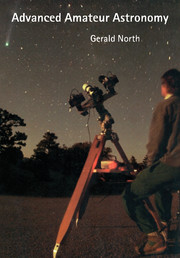Book contents
- Frontmatter
- Contents
- Preface to the second edition
- Preface to the first edition
- Acknowledgements
- 1 Telescope optics
- 2 Atmosphere, seeing, magnification and eyepieces
- 3 Telescope hardware and adjustments
- 4 Astrophotography with the camera
- 5 Astrophotography through the telescope
- 6 Electronic imaging
- 7 The Moon
- 8 The terrestrial planets
- 9 The gas-giant planets
- 10 Asteroids, comets, meteors and aurorae
- 11 The Sun
- 12 Variable stars and novae
- 13 Methods of photometry
- 14 Double stars, star clusters, nebulae, galaxies and supernovae
- 15 Spectroscopy
- 16 Radio astronomy
- 17 Further information
- Appendix: Useful formulae
- Index
- Frontmatter
- Contents
- Preface to the second edition
- Preface to the first edition
- Acknowledgements
- 1 Telescope optics
- 2 Atmosphere, seeing, magnification and eyepieces
- 3 Telescope hardware and adjustments
- 4 Astrophotography with the camera
- 5 Astrophotography through the telescope
- 6 Electronic imaging
- 7 The Moon
- 8 The terrestrial planets
- 9 The gas-giant planets
- 10 Asteroids, comets, meteors and aurorae
- 11 The Sun
- 12 Variable stars and novae
- 13 Methods of photometry
- 14 Double stars, star clusters, nebulae, galaxies and supernovae
- 15 Spectroscopy
- 16 Radio astronomy
- 17 Further information
- Appendix: Useful formulae
- Index
Summary
In the post-Apollo years there was a growing feeling among amateur astronomers that lunar observation was no longer worthwhile. Moon mapping had been all but completed by the Orbiter probes of the 1960s and men had been to the Moon's desolate surface and brought back samples of lunar rock and soil. Even so, there is still much we do not know. Even to this day there are still one or two areas of research that can profitably be undertaken by the careful amateur.
Selenographic longitude and latitude
Old and new maps of the lunar surface differ in their definition of east and west. On the classical scheme the Mare Crisium was to the west and the Oceanus Procellarum to the east. The modern scheme, due to the International Astronomical Union (IAU), is that the Mare Crisium lies to the east. Coordinates measured with respect to the surface of the Moon are termed selenographic. Libration affects the apparent positions of features on the Moon's surface but the mean position of the meridian corresponds to a selenographic longitude of 0°. Selenographic longitude increases eastwards (towards the Mare Crisium) and is 90° at the mean east limb. It further increases, through 180° at the mean position opposite the Earth, to 270° at the mean west limb. From the mean west limb the selenographic longitude increases further to 360° (equivalent to 0°) at the meridian.
- Type
- Chapter
- Information
- Advanced Amateur Astronomy , pp. 157 - 179Publisher: Cambridge University PressPrint publication year: 1997



